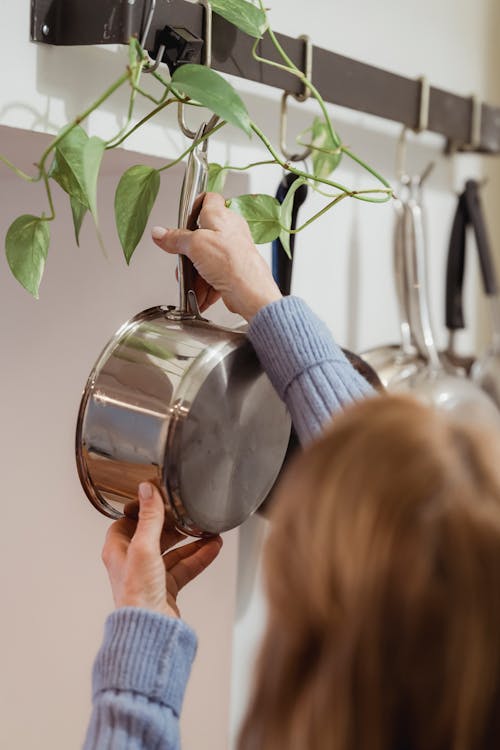Stainless steel is a favorite in modern kitchens for good reason – it’s sleek, durable, and easy to clean. But, as with any kitchen appliance or cookware, it needs proper maintenance to maintain its shine and prevent damage. Fear not! We’ve got you covered with a complete guide on how to clean stainless steel appliances, cookware, and sinks.

How to Clean Stainless Steel Kitchen Appliances
Stainless steel appliances are an investment, and maintaining their shine and luster is essential for their longevity. Here’s how to clean stainless steel appliances:
Step 1: Dust off the surface of the appliance with a soft cloth or microfiber towel to remove any loose dirt or debris.
Step 2: Mix a cleaning solution of warm water and a mild detergent or dish soap.
Step 3: Dip a soft cloth or sponge into the cleaning solution and wipe the surface of the appliance in the direction of the grain.
Step 4: Rinse the cloth or sponge thoroughly and wipe the surface again to remove any residue.
Step 5: Dry the appliance with a clean, dry microfiber towel to prevent water spots and streaks.
The Basics of Cleaning Stainless Steel Appliances
To keep your stainless steel appliances looking their best, it’s important to follow these basic cleaning tips:
- Always wipe in the direction of the grain to prevent scratching the surface.
- Avoid using abrasive sponges or cleaning products that can scratch the surface.
- Never use bleach or chlorine-based cleaners on stainless steel, as they can cause discoloration.
- Avoid leaving water or cleaning solutions on the surface for an extended period, as it can cause discoloration or damage.
How To Remove Tough Stains From Stainless Steel
Despite your best efforts, your stainless steel appliances may encounter tough stains that need special attention. Here’s how to remove them:
- Grease or oil stains: Mix baking soda and water to create a paste. Apply the paste to the stain and let it sit for 15-20 minutes. Scrub the area with a soft-bristled brush and rinse with warm water.
- Water spots: Mix equal parts vinegar and water in a spray bottle. Spray the solution on the affected area and let it sit for 5-10 minutes. Wipe the surface with a soft cloth and rinse with warm water.
- Rust stains: Create a paste of baking soda and water and apply it to the stain. Let it sit for 15-20 minutes and scrub with a soft-bristled brush. Rinse with warm water.
How To Clean Stainless Pans and Cookware
Stainless steel cookware is durable, long-lasting, and can withstand high temperatures. Here’s how to clean stainless steel pans and cookware:
Step 1: Allow the cookware to cool down to room temperature before cleaning.
Step 2: Soak the cookware in warm, soapy water for a few minutes.
Step 3: Use a soft-bristled brush or sponge to scrub the surface of the cookware.
Step 4: Rinse with warm water and dry with a clean, dry towel.

Stainless steel sinks are durable and resistant to stains and rust. However, they can develop water spots and discoloration over time. Here’s how to clean stainless steel sinks:
Step 1: Remove any food debris or other particles from the sink.
Step 2: Mix a solution of warm water and dish soap.
Step 3: Dip a soft-bristled brush or sponge into the solution and scrub the sink in a circular motion.
Step 4: Rinse the sink with warm water and dry with a clean, dry cloth.
Step 5: For extra shine and to prevent water spots, you can use a homemade solution of equal parts water and vinegar or rubbing alcohol. Apply the solution to a clean cloth and wipe down the sink, following the grain of the stainless steel.
Step 6: To remove tough stains or discoloration, you can use a paste made from baking soda and water. Apply the paste to the sink with a soft-bristled brush or sponge and let it sit for 15-20 minutes. Then, rinse the sink with warm water and dry with a clean, dry cloth.
Step 7: For extra protection against scratches and water spots, you can apply a stainless steel protectant or polish. Follow the instructions on the product label for best results.
Frequently Asked Questions About Stainless Steel:
- Does vinegar harm stainless steel?
Vinegar is a natural cleaning agent that is safe to use on stainless steel. However, it should be diluted with water before use and should not be left on the surface for an extended period of time as it can cause discoloration.
- Does dish soap ruin stainless steel?
No, dish soap is safe to use on stainless steel. However, it’s important to choose a gentle dish soap and avoid abrasive scrubbers or sponges that can scratch the surface.
- Does alcohol ruin stainless steel?
No, rubbing alcohol is safe to use on stainless steel. In fact, it can be used to remove tough stains and water spots.
- Can I use olive oil to polish stainless steel?
Yes, you can use olive oil to polish stainless steel. Apply a small amount of olive oil to a clean cloth and rub it onto the stainless steel in a circular motion. Then, buff the surface with a clean, dry cloth to remove any excess oil.
Conclusion:
Stainless steel is a popular choice for kitchen appliances, cookware, and sinks due to its durability and resistance to stains and rust. However, it’s important to clean and maintain stainless steel properly to keep it looking its best. By following the tips and techniques outlined in this ultimate guide, you can keep your stainless steel surfaces clean, shiny, and free of tough stains and discoloration. Remember to use gentle cleaning agents, avoid abrasive scrubbers or sponges, and always dry the surface thoroughly to prevent water spots. With the right care and maintenance, your stainless steel surfaces can look like new for years to come.

